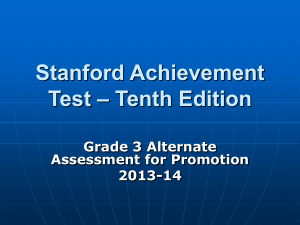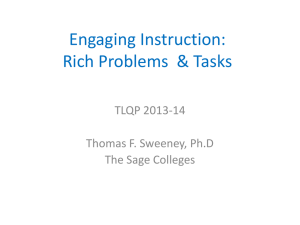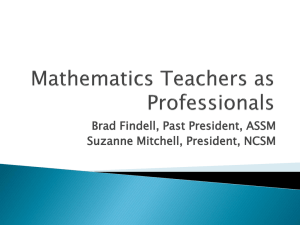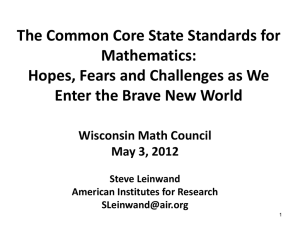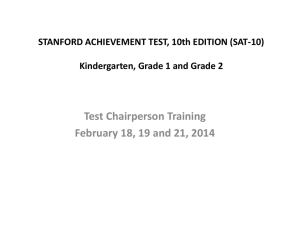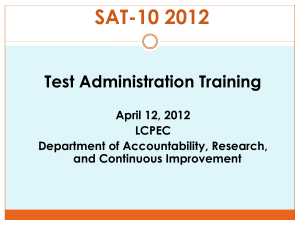Transitioning into the Common Core Standards K-2 Math
advertisement
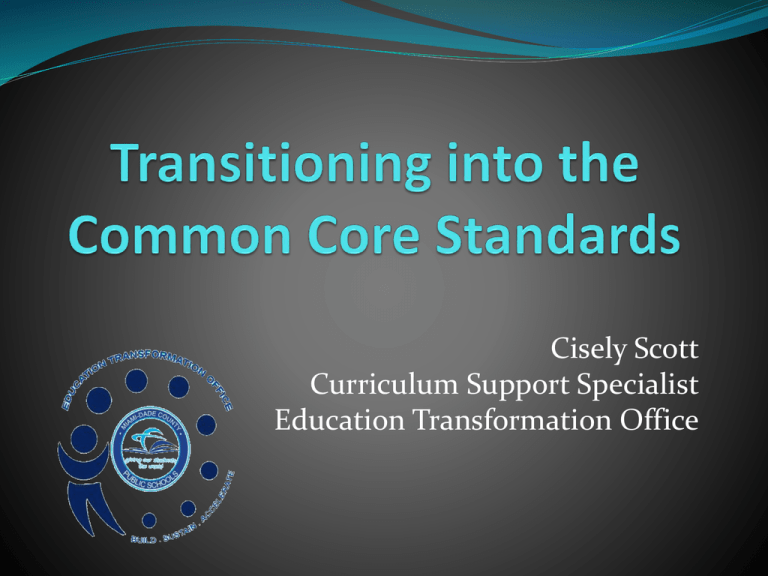
Cisely Scott Curriculum Support Specialist Education Transformation Office Common Board Configuration (CBC) DATE: August 12, 2011 BENCHMARK: Common Core Standards OBJECTIVE: Today we will examine the common core standards and determine ways to transition smoothly into teaching these standards. VOCABULARY: Common Core, domain, focal points, clusters, standards, SAT10 • • • • • • ESSENTIAL QUESTION: How can understanding the common core standards impact your teaching and increase student achievement? AGENDA: Why Common Core Standards? Layout of Standards NGSSS vs. Common Core Standards How to teach the common core with NGSSS materials? SAT-10 implications Reflection: How can understanding the common core standards impact your teaching and increase student achievement? EXIT SLIP: IN YOUR JOURNAL Connect: Write about 3 new things that you learned today and how this will help you in the classroom? Connect: How can understanding the common core standards impact your teaching and increase student achievement? HOME LEARNING: Review today’s lesson and develop your next steps to use this information n your classroom. ESSENTIAL QUESTION HowFlorida can Education: understanding the common core The Next Generation DRAFT standards impact your teaching and increase March 13, 2008 student achievement? Version 1.0 Now that you have learned the NGSSS, we have new common core standards! Five Steps Toward Building Globally Competitive Education Systems Action 1: Upgrade state standards by adopting a common core of internationally benchmarked standards in math and language arts for grades K-12 to ensure that students are equipped with the necessary knowledge and skills to be globally competitive. Action 2: Leverage states’ collective influence to ensure that textbooks, digital media, curricula, and assessments are aligned to internationally benchmarked standards and draw on lessons from high-performing nations and states. Action 3: Revise state policies for recruiting, preparing, developing, and supporting teachers and school leaders to reflect the human capital practices of top-performing nations and states around the world. Action 4: Hold schools and systems accountable through monitoring, interventions, and support to ensure consistently high performance, drawing upon international best practices. Action 5: Measure state-level education performance globally by examining student achievement and attainment in an international context to ensure that, over time, students are receiving the education they need to compete in the 21st century economy. Myths and Realities about International Comparisons Myth 1: Other countries test a more select, elite group of students. Myth 2: The U.S. performs poorly because of poverty and other family factors. Myth 3: Cultural factors prevent U.S. students from performing as well as those in other nations, particularly Asian countries. Myth 4: Other countries are less diverse. Myth 5: Wealthier countries spend more than the U.S. on education. Myth 6: U.S. attainment rates cannot be compared with other countries’ because the U.S. tries to educate many more students. Myth 7: Education does not really affect the economy anyway. A Nation at Risk warned that America’s economy would suffer, but that never happened. COUNCIL OF CHIEF STATE SCHOOL OFFICERS (CCSSO) & NATIONAL GOVERNORS ASSOCIATION CENTER FOR BEST PRACTICES (NGA CENTER) JUNE 2010 IN THE STATES Common Core Development Initially 48 states and three territories signed on As of now, 44 states have officially adopted Final Standards released June 2, 2010, at http://www.corestandards.org/ Adoption required for Race to the Top funds What are the Common Core State Standards? State led – coordinated by NGA Center and CCSSO Aligned with college and work expectations Focused and coherent Include rigorous content and application of knowledge through high-order skills Build upon strengths and lessons of current state standards Internationally benchmarked so that all students are prepared to succeed in our global economy and society Based on evidence and research Why is this important? Currently, every state has its own set of academic standards, meaning public education students in each state are learning to different levels All students must be prepared to compete with not only their American peers in the next state, but with students from around the world The American Recovery and Reinvestment Act of 2009: Saving and Creating Jobs and Reforming Education Four principles guide the distribution and use of ARRA funds: Spend funds quickly to save and create jobs. Improve student achievement through school improvement and reform. Ensure transparency, reporting and accountability. Invest one-time ARRA funds thoughtfully to minimize the "funding cliff." http://www2.ed.gov/policy/gen/leg/recovery/implementation.html Race to the Top Funds . . . to improve education quality and results statewide. will help states drive substantial gains in student achievement by supporting states making dramatic progress on the four reform goals and effectively using other ARRA funds. Benefits for States and Districts Allows collaborative professional development based on best practices Allows development of common assessments and other tools Enables comparison of policies and achievement across states and districts Creates potential for collaborative groups to get more economical mileage for: Curriculum development, assessment, and professional development Common Core Mission Statement The Common Core State Standards provide a consistent, clear understanding of what students are expected to learn, so teachers and parents know what they need to do to help them. The standards are designed to be robust and relevant to the real world, reflecting the knowledge and skills that our young people need for success in college and careers. With American students fully prepared for the future, our communities will be best positioned to compete successfully in the global economy. Standards Development Process College and career readiness standards developed in summer 2009 Based on the college and career readiness standards, K-12 learning progressions developed Multiple rounds of feedback from states, teachers, researchers, higher education, and the general public Final Common Core State Standards released on June 2, 2010 The Five Strands of Mathematics Proficiency Developing Mathematicians CCSSM 8 Mathematical Practices The Common Core proposes a set of Mathematical Practices that all teachers should develop in their students. These practices are similar to NCTM’s Mathematical Processes from the Principles and Standards for School Mathematics. Standards for Mathematical Practice Carry across all grade levels Describe habits of mind of a mathematically expert student Make sense of problems and persevere in solving them Reason abstractly and quantitatively Construct viable arguments and critique the reasoning of others Model with mathematics Use appropriate tools strategically Attend to precision Look for and make use of structure Look for and express regularity in repeated reasoning STANDARDS WERE ADOPTED FOR MATHEMATICS JUNE 2010 Curriculum Correlation CCSSM v. NGSSS Define characteristics of the Common Core State Standards Begin to understand the nature of the shifts needed to implement the Common Core State Standards Launch your work in analyzing these standards Clusters are groups of related Domains are large groups of related standards. Standards from different domains may sometimes be closely related. Look for the name with the code number on it for a Domain. standards. Standards from different clusters may sometimes be closely related, because mathematics is a connected subject. Standards define what students should be able to understand and be able to do- part of a cluster Design and Organization Focal points at each grade level Design and Organization Grade Level Overviews (not all content is shown below) Number and Operations, Grade 1 (not all grade 1 content is shown below) Number and Operations in Base Ten Extend the counting sequence. Understand place value. Use place value understanding and properties of operations to add and subtract. Operations and Algebraic Thinking Represent and solve problems involving addition and subtraction. Understand and apply properties of operations and the relationship between addition and subtraction. Add and subtract within 20. Work with addition and subtraction equations. Summary Focus and Coherence Focus on key topics at each grade level. Coherent progressions across grade levels. Balance of Concepts and Skills Content standards require both conceptual understanding and procedural fluency. Mathematical Practices Foster reasoning and sense-making in mathematics. College and Career Readiness Level is ambitious but achievable. Conclusion The Promise of Standards: These Standards are not intended to be new names for old ways of doing business. They are a call to take the next step. It is time for states to work together to build on lessons learned from two decades of standards based reforms. It is time to recognize that standards are not just promises to our children, but promises we intend to keep. You can ask questions by typing your question into the Q&A panel and clicking "send.“ Webinar recording will be available at www.corestandards.org Transitioning into Common Core Still utilize the GoMath textbook Use additional GoMath lessons to address the common core These resources will be provided Utilize updated pacing guides SAT-10 SAT-10 will remain the same SAT-10 topics will be infused by the pacing guide District will provide dailies to address SAT-10 SESAT 2 Standards: Patterns, Relationships, and Algebra Identify and copy a pattern with a color, size, shape, or number. Identify missing elements in a pattern. Fractions Match pictorial models to fraction names and notation Solve problems involving fraction concepts Data, Statistics, and Probability Identify possible outcomes Read and interpret tables and graphs Time and Calendar Solve problems involving calendar concepts Tell time to the nearest hour TOPIC XIV: SAT-10 REVIEW Primary 1 Standards assessed on SAT-10 not on CCSSM/NGSSS: Number Sense and Operations Solve problems involving fraction concepts Identify and use field properties of addition and multiplication Patterns, Relationships, and Algebra Translate problem situations into algebraic equations and expressions Extend a numerical patterns Data, Statistics, and Probability Read and interpret Venn diagrams Read and interpret tables and graphs Identify possible outcomes Solve problems involving tables and graphs Time and Calendar Calculate the value of sets of coins Estimate or measure length using customary, metric, or non-standard units Estimate or measure temperature using customary or metric units Solve problems involving calendar concepts Solve problems involving elapsed time Reflection Now that you know about the common core standards write about how the understanding of the common core standards will impact your teaching and student achievement.


